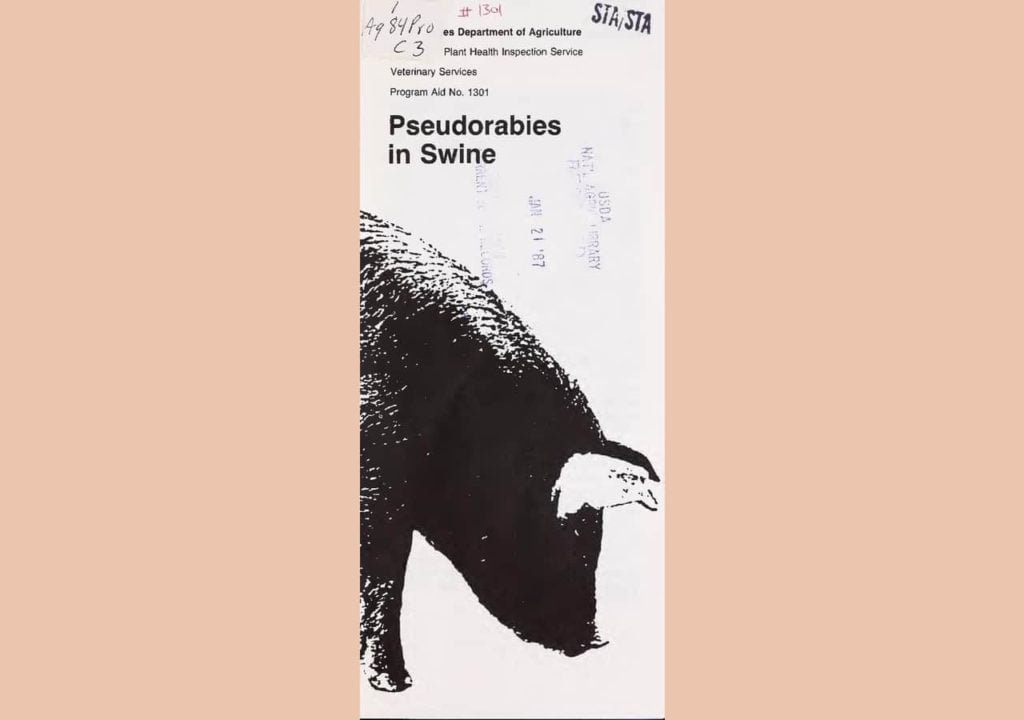Aujeszky Disease
Aujeszky disease is a viral disease that preferentially affects pigs but can exceptionally affect carnivores, ruminants (herbivorous animals) and equines (horse family). It has become increasingly important throughout the world since its identification by a Hungarian veterinarian in 1902.
It is due to a herpes virus responsible in dogs for encephalomyelitis that rapidly progresses to death. The contamination of the dog is done by the ingestion of viscera of pig or wild boar contaminated by the virus. This disease is not transmissible to humans.
Infection with a herpes virus, Suid herpesvirus 1 (SHV)
Infection with a herpes virus, Suid herpesvirus 1 (SHV) is the virus that causes Aujeszky’s disease (or pseudorabies). Its name is due to the discoverer of the disease it causes: Aladár Aujeszky.
Aladár Aujeszky (born January 11, 1869 in Pest, now Budapest – † March 9, 1933 in Budapest) was a Hungarian veterinary pathologist and microbiologist .
Aujeszky taught in Budapest and in 1902 was the first to describe the viral disease of pigs named after him, Aujeszky’s disease . He was a student of Endre Högyes. From 1907 to 1933 he worked as director of the Institute of Bacteriology of the Royal Hungarian Veterinary College.
CAUSES OF DISEASE
The agent of Aujeszky’s disease is a virus from the Herpesviridae family, a virus moderately resistant in the external environment.
EPIDEMIOLOGY | study and analysis of the distribution (who, when, and where)
Disease may vary depending on the age and species of animal affected; younger animals are the most severely affected. Piglets usually have a fever, stop eating, and show neurological signs (seizures, paralysis), and often die within 24-36 hours.
Infected pigs are the main source of spread of the virus. The other species are affected only exceptionally. And do not constitute a source of infection given the manifestation of symptoms (nervous) and their extremely rapid mortality (24 to 48 hours), which interrupts the spread of the virus.
The virus is excreted by pigs into the external environment via nasal and oral secretions, etc. Thus, it is found in manure, soil, on objects, etc. Its survival in the external environment is variable (around a few days to a few weeks) depending on the climatic conditions and the type of soil. Equidae can be contaminated orally via contaminated secretions (by contact with other infected pigs, for example) or via contaminated soil or objects. However, this contamination is exceptional.
SYMPTOMS of Aujeszky Disease
The incubation period varies from 3 to 6 days. Symptoms in equines are nervous and can evoke those related to rabies (hence the name sometimes given pseudorabies to Aujeszky’s disease). The most frequent signs are: agitation, difficulty breathing, salivation, muscle tremors… Lying sideways, the animals pedal in a vacuum and show spasms of the head, neck and abdominal muscles. Equines oscillate between states of excitement and depression.
Read also: How To Educate Cat | How to properly educate a kitten?
Not always observed, animals may continually scratch and lick their shoulders and limbs, even inflicting open wounds. This disease leads to the death of the animal very quickly (24 to 48 hours) and sometimes so suddenly that no typical symptoms have time to appear.
Systems Affected
- Nervous system diseases of large ruminants (herbivorous animals, i.e.: cow, goat, giraffe, horse, deer, donkey, buffalo, sheep, camel, rabbits, kangaroo, squirrel, koala, zebra, yak, mouse, panda, gorilla, elephant, tortoises…)
- Nervous system diseases of pigs (sucking and weaned)
- Nervous system diseases of small ruminants
- Respiratory diseases of pigs
DIAGNOSTIC of Aujeszky Disease
The diagnosis of Aujeszky’s disease is exclusively virological on brain samples as for rabies.
TREATMENT & PREVENTION
Treatment
At the moment, there is no treatment for this viral disease which is both very rare but always fatal very quickly.
Medical prevention
Due to the rarity of this disease, there is no medical prevention.
Health prevention
Still in cases of exceptional contamination, no health prevention can be applied.
Information: Cleverly Smart is not a substitute for a doctor. Always consult a doctor to treat your health condition.
Resources: PinterPandai, Food and Agriculture Organization (FAO), Gov.UK, CAB International
Photo credit: United States. Department of Agriculture / Wikimedia Commons
Author: United States. Department of Agriculture. Title: Pseudorabies in swine.
Source: CAT31108400, https://archive.org/download/CAT31108400/CAT31108400.pdf
Permission (Reusing this file): The contributing institution believes that this item is not in copyright.

